Don’t we all love cameras with wide viewing angles?
Ones that can work like powerful fish-eye lenses.
Capturing the widest possible shots.
And offering the required level of visual distortion to make panoramic or even hemispherical shots realities.
Yes, those cameras are excellent.
But they fall short if you want something for churches, guard stations, museums, and large outdoor areas.
At this point, all you need is a PTZ camera.
And in case you don’t know, PTZ stands for Pan-Tilt-Zoom.
But then, do you really know a lot about PTZ camera systems?
If you, follow along as I dissect every aspect of standard PTZ cameras.
The discussion will include the ways to connect, types, features, advantages, mounting ideas, and even some FAQs to address the standard user queries. So let’s get down to business.
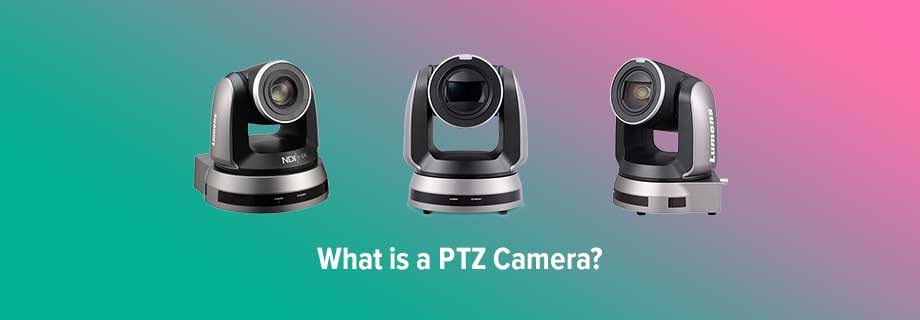
Design & Functionality of PTZ Cameras
Aesthetics first, as it’s always interesting to look at PTZ cameras up close.
Most PTZ cameras are dome-shaped, but you can get bullet-shaped variants as well.
Also, as I talk about the mounting options, you will know a bit more about the design aspects of the same.
Keeping the mounting aspects in mind, PTZ cameras can be recessed, surface adhering, or even hanging.
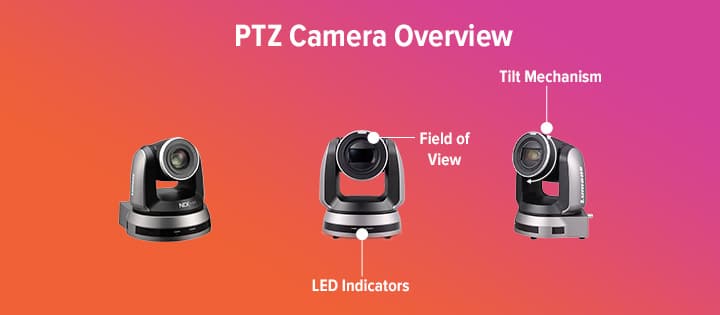
Connectivity-wise, Pan-Tilt-Zoom cameras bring a lot to the table.
The options include USB support for wired video conferring & plug-and-play usage, HDMI Ports for setting up extension systems using external displays, SDI ports for using the camera as production switchers, and even high-speed wireless standards to help use them as IP cameras.
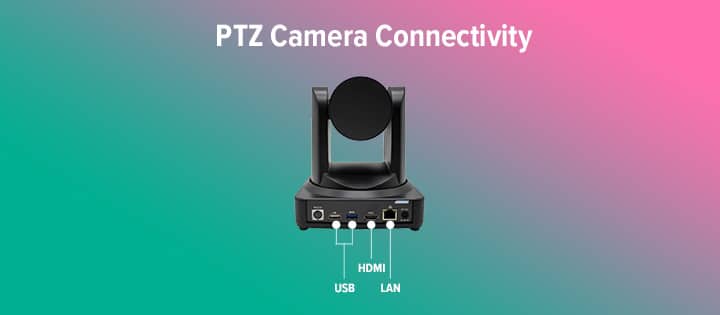
The choice of connectivity also determines the type of PTZ camera you get.
And while the connectivity choices are determined by the video output you prefer, some devices even support Ethernet connectivity.
This functionality works if you want the cameras to draw power via PoE (Power over Ethernet) while being connected to routing switches.
Apart from connectivity, you also need to keep an eye on the mounting options.
Some of them include pole-mount, ceiling-mount, and standard wall-mount.
Different mounts have different utilities.
For instance, pole mounts are good for churches, ceiling mounts are meant for enclosed areas, and wall-mounted PTZs are perfect for balconies or semi-opened spaces.
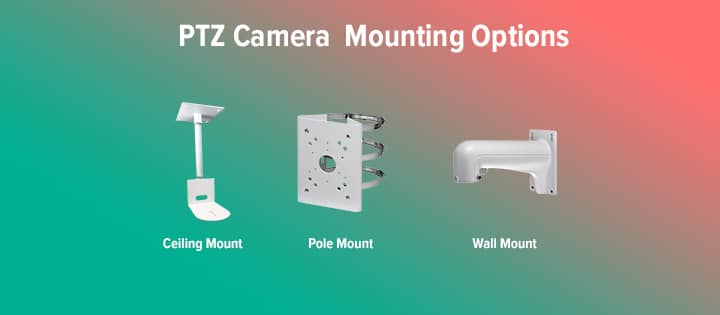
How Do PTZ Cameras Work?
Pan-Tilt-Zoom cameras comprise mechanical parts that can be controlled depending on the functionality you choose.
In most cases, they are remotely controlled via software and presets.
For instance, PTZ cameras quite appropriately can pan, tilt, and zoom depending on the pre-installed camera presets.
These presets are summoned voluntarily to align the camera to the specific user requirements.

As far as controlling the camera is concerned, you can either use software and control the device from the computer, joystick controller, or the IR remote.
However, if you are to narrow it down, IR remote-controlled PTZ cameras are better bets for close-range shooters, whereas joystick-controlled ones make sense if you are using an array of these cameras connected using serial cables or ethernet.
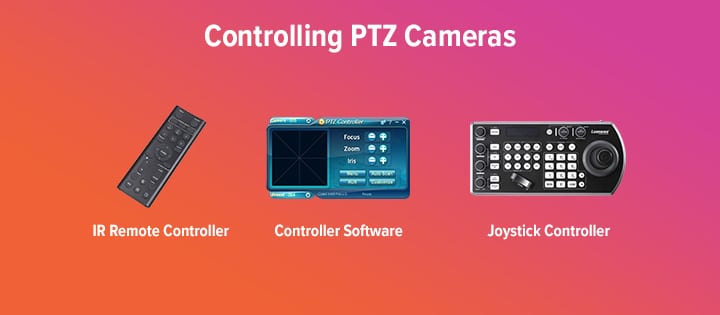
Software-controlled PTZ cameras are most common and can be used for covering events and training instances.
And yes, some of the common software solutions that might just work well with your PTZ camera include MimoLive, Wirecast, and more.
Depending on the functionality offered, PTZ cameras are further segregated as outdoor, analog, IP, and wireless cameras.
Features of the PTZ Cameras
Now that you have a fair idea about the aesthetics and modus operandi of PTZ cameras, here are certain features that make them stand out from the herd.
1. Pan-Tilt-Zoom Functionality
PTZ cameras are supposed to handle the Pan, Tilt, and Zoom functionality.
This means you can use them to swivel both left and right as panning, move up/down as tilting, and zoom both in and out, depending on the scene and user requirements.
To summarize, they can cover 360 degrees if you combine each of the three utilities together.
2. Large Field
As mentioned, these cameras are designed to cover a lot when it comes to the area.
Some software-controlled models are also developed to track motion and cover progressive areas as well.
The area starting at zero-pan, zero-tilt, and zero-zoom can be considered as the starting point for PTZ, which can then scale their field by up to 180 degrees across every vertical to cover an insane amount of real estate.
3. Remote Control
Well, there are quite a few controlling mechanisms that PTZs cameras are expected to offer.
As mentioned, you can consider investing in an IR remote-controlled camera, joystick-controlled PTZ, or a software-controlled, preset-packed camera to make management easier.
4. Auto-Tracking
Some advanced PTZ cameras are stacked with motion sensors or movement monitors to modify their pan, tilt, and zoom measurements automatically.
These auto-tracking PTZs are a tad pricey but can fit in really well in areas that are quiet and require constant monitoring.
5. Auto Scanning
Software or preset-powered PTZ cameras are often pre-adjusted to scan specific areas and even timestamp the feed for future reference.
Also, the presets can be programmed to change and reconfigure the Pan-Tilt-Zoom to get the most out of time-based scanning.
These models are typically meant for areas that are difficult to access normally but require surveillance.
6. Zooming
Isn’t zoom a featured PTZ trait?
Well, it is, but there are certain models that offer enhanced optical zooming functionalities that can go up to 40x, thereby helping you lock in some faraway objects, including faces and license plates, with relative ease.
Rings a bell, doesn’t it. Well, say no to overspeeding then.
7. Digital Pan/Tilt
Certain PTZ cameras offer digital panning and tilting support, allowing you to change certain facets of the video after it has been recorded.
But then, you first need to check with the manufacturer to see whether the model supports the same or not.
Frequently Asked Questions
What does the PTZ camera do?
In simple terms, PTZ cameras are meant to move in a three-dimensional space, either across 180 degrees or 360 degrees, to cover the widest and farthest area possible.
What are the different types of PTZ cameras?
Different types of PTZ cameras include analog cameras that are connected using coaxial cables, outdoor cameras that are mostly weatherproof, wireless cameras with built-in presets, and IP cameras that can be both PoE-based or wireless, depending on your preferences.
Are PTZ cameras worth it?
If you are willing to ignore the slightly higher costs, these cameras are excellent picks, especially for museum, airport, church, guard station, and supermarket surveillance.
How much does a PTZ camera cost?
PTZ cameras can cost anywhere between $200 to $1000 dollars, depending on the functionality you seek.
However, some high-end models with digital panning and tilting support, motion tracking, auto scanning, and other utilities can go as high as $10,000.
How long do PTZ cameras last?
Well, a standard PTZ camera is expected to last 5 years at once.
However, weatherproof models that set you back by much are even good enough to last a decade, that is 10 years.
Conclusion
Pan-Tilt-Zoom or PTZ cameras are highly resourceful electronic devices.
Suppose you really want to pick one.
In that case, you must first ascertain your exact needs, including the premise to be covered, built-in storage space, need for additional visibility, type of cabling that the concerned establishment permits, preferred mounting type, and even the environment where the camera is to be housed.
Once all these factors are considered, you are good to pick the model that makes sense, even to your wallet.
Suggested Article: Best PTZ Cameras for Churches








